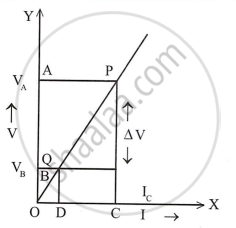Advertisements
Advertisements
Question
Draw a I–V graph for a linear resistor. What does its slope represent?
Solution

One draws an I-V graph of a linear resistor. The slope represents the conductor's resistance, R.
Slope `("V"_"A" - "V"_"B")/("I"_"C" -"I"_"D")`
`(Δ "V")/(Δ "I") = "R"`
Graph for V vs I or slope
`(Δ "I")/(Δ "V") = 1/("Resistance of the conductor")`
APPEARS IN
RELATED QUESTIONS
Two wires of the same material and same length have radii 1 mm and 2 mm respectively. Compare their resistances.
How are the home appliances connected in general, in series or parallel. Give reasons.
Exercise.
The values of current (I) flowing through a resistor for various potential differences V across the resistor are given below. What is the value of resistor?
| I (ampere) | 0.5 | 1.0 | 2.0 | 3.0 | 4.0 |
| V (volt) | 1.6 | 3.4 | 6.7 | 10.2 | 13.2 |
The effective resistance of three resistors connected in series is lesser than the lowest of the individual resistances.
The resistance of a straight conductor is independent of ______.
If the area of cross-section of the conductor is doubled its resistance gets ______.
Three resistors are connected in series with a cell. If the current in each resistor is 1.5A, then the current through the cell will be ______.
Match the following:
| Column I | Column II | ||
| 1. | Resistor | a. | Galvanometer |
| 2. | Connecting wire | b. | Voltmeter |
| 3. | Current in an electric circuit | c. | Copper |
| 4. | Potential difference | d. | Constantan |
Define the following:
One ohm
Define the following:
Fixed resistor
